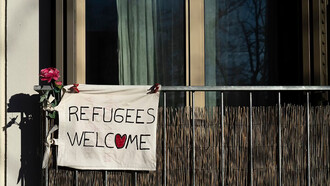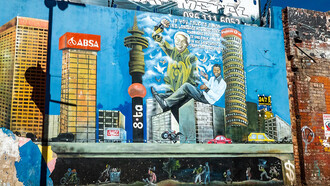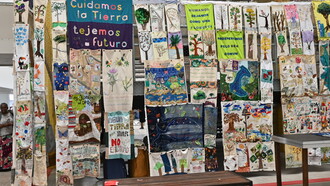The long-simmering tension between the two most populated and powerful countries in Asia, China and India, has, every once in a while, broken out into armed conflict. Most recently in 2020, China took over a chunk of the high-altitude territory of Ladakh in India, and it took 4 years to resolve the issue. But it remains an uneasy truce, with the region continuing to smolder with tension. Now, another move by China is threatening to make a fraught situation worse—the proposed construction of the world’s largest hydroelectricity dam on the Yarlong Tsangpo River in Tibet, just north of Arunachal Pradesh in India. What is most vexing, from India’s point of view, is that this will severely disrupt flows of this river into its territory, where it is known as the Siang, becoming the main tributary of the Brahmaputra (‘son of Brahma,’ the creator of the universe in Hindu mythology). These rivers are the lifeline of tens of millions of people, as well as a huge diversity of wildlife.
Political boundaries disrupt natural and cultural flows
Amongst the underlying causes of these frequent outbreaks of conflict is the division of South Asia into nation-states, each able to decide on the use of its territory regardless of the consequences on neighbors. China is not the only aggressor. India, when it built the Farakka Barrage or in other ways diverted the Ganga, ignored the negative impacts on communities in Bangladesh and is currently planning dams on the Indus, which will have such impacts on Pakistan’s people and wildlife. Long-standing tension between India and Pakistan has meant that the entire boundary area between the two is militarised, blocking millennia-old migration of wildlife and centuries-old movement of nomadic pastoralists and traders. Some amount of transboundary cooperation, for instance, between India and Bhutan in conserving adjoining tiger habitats, has averted some negative impacts. But these are exceptions.
Conflicts between the countries of South Asia are very likely to get worse, as the climate crisis bears down on it. For instance, sea level rise across the coasts will push people inland. Where such movement is attempted across national boundaries (e.g. from Bangladesh into India), it will be seen as unwanted incursions and interpreted not only as putting pressure on already heavily used land and other resources but also as religious clashes (especially if religiously bigoted political parties are in power at the centre and relevant states in India).
The problems with current political boundaries are not only between nation-states but within them too. For instance, India’s biggest HE project is being proposed on the Siang in Arunachal Pradesh, which is likely to have serious impacts on downstream populations and states. Assam has been raising objections for many years about dams in the upstream state of Sikkim, and one of India’s longest-standing interstate conflicts is with regard to the diversion of waters of the River Kaveri by Karnataka, with impacts on downstream Tamil Nadu.
Given these situations, what could a vision of South Asia look like that takes into account crucial natural, cultural, and economic flows? For the purposes of this article, I am considering South Asia as encompassing Pakistan, India, Nepal, Bhutan, Sri Lanka, Bangladesh, Burma/Myanmar, and Tibet occupied by China. The vision below builds on a futuristic piece that my colleague KJ Joy and I wrote in the book Alternative Futures: India Unshackled and from the work of the South Asia Bioregionalism Working Group. It is unapologetically utopian in scope but also provides some earthy pathways of getting closer to such an ideal vision. I acknowledge, of course, the enormous challenges confronting such pathways, and while not belittling them, I want to also stress a learning from history: humans are capable of incredible breakthroughs in achieving what may seem impossible once they put their minds and hearts behind them.
Biocultural transformation: the view in 2100
Beginning with a series of cross-national people-to-people dialogues in the early 2000s and the assertion of local community decision-making and commons governance in the border areas, the boundaries between nation-states became less rigid. Across the entire India-Pakistan-China-Bangladesh border areas, then heavily conflict-ridden, fenced, and army-occupied, pastoral, farming, and trading communities declared shanti abhyaranyas (peace sanctuaries). Slowly, fences came down, and armed forces withdrew. Border tourism, initiated in the 2020s, helped in this, especially where it was community-managed.
In the Palk Strait, fishing communities from India and Sri Lanka took on the sustainable, peaceful use of marine and coastal areas; the same for the mangrove ecosystem of the Sundarbans across India and Bangladesh. From the 2030s onwards, considerable people’s pressure over a couple of decades led to India, China, and Pakistan relinquishing their political and economic domination over the Tibet-Ladakh-Gilgit-Baltistan region, enabling mountain communities across this vast area to take over.
People and wildlife were able to move freely across again (like the European Union, the South Asian region became visa-free). One process that helped tremendously in this was the mapping of the biocultural regions of South Asia—focusing especially on river basins and watersheds, mountain ranges, contiguous forests, wetlands, grasslands, coastal and desert ecosystems, and agroecological zones. The foundations of this mapping included memory and historical records of biocultural regions (known by diverse names, e.g., ilaka, aanchal, chak) that existed prior to the colonisation of the subcontinent, some studies of which were carried out in the 2020s. Additional bases for this mapping have been agro-ecological, hydro-topographical, monsoonal, and forest mapping by relevant institutions using modern technologies, demographic patterns, and other crucial elements.
Dramatic transformations have been made in re-establishing natural flows that had earlier been disrupted. This included, after considerable resistance from governments and also some parts of the public, the decommissioning of dams and barrages. From the 2030s, this was progressively done for all rivers, both to restore their crucial functions and as a recognition of their own right to freedom. Special attention was given to rivers flowing across what were once nation-states, such as Indus/Sindhu/Singhe Khababs, Ganga and its tributaries, and Yarlung Tsangpo/Brahmaputra. Resistance from the public, which feared loss of power and irrigation benefits, was reduced by the spread of decentralised energy and water sources and demand management, including the elimination of luxury and wasteful consumption.
Both nomadic communities and wildlife are now able to move freely back and forth, as they used to before these areas became zones of conflict and were dissected by fences. The transboundary elements of nature and resources in the region—like water, forests, and migratory species—are being increasingly brought under a regional public good framework of governance.
Populations of several plant and animal species that were in decline due to blockages in their migration and movement patterns, or fragmentation of habitats, have revived or are in the process of revival. This includes, for instance, Gangetic dolphins, hilsa fish, and otters in the rivers freed of dams and diversions; several cat species in the Sundarbans and the contiguous forest areas of northeast India, Myanmar, and Bangladesh; snow leopards, markhor, musk deer, and many other mountain species in the transboundary Himalayan landscapes; dugongs, sea turtle species, and others in the marine/coastal areas between India, Sri Lanka, and Southeast Asia.
A crucial component of this was also the integration of knowledge on changing weather patterns due to the climate crisis; while much of this was hard to predict, a robust system of constant feedback and adaptations helped reduce the uncertainty. The traditional knowledge of working with fluidity, e.g., in the case of rivers that have frequently changed course, or in the case of oceanic and coastal processes, also helped in building in such adaptability.
Real democracy vs. the nation-state
Beginning in the early 2000s, collectives of various kinds (village assemblies, city neighbourhoods, common interest groups, alliances of people’s movements) began asserting their role in decision-making. This began with some initiatives towards swaraj or radical democracy, where communities took back control over matters affecting their lives (including their means of production such as land, forests, and knowledge) and evolved principles of decision-making like consensus instead of voting in which the majority dominates. It was, however, not enough for each community to govern itself, so they also evolved institutions for governance and management of larger biocultural regions. Communities increasingly learnt, or revived from traditional ways of being, how to communicate with the rest of nature to enable various forms of ‘earthy governance’ in which the voice of other species plays a crucial part.
Through this, local communities have taken over most of the governance of the commons and decide on most matters affecting their lives, with landscape-level institutions for governance that are accountable to those on the ground. Some forms of the state still exist now for larger-scale decision-making, but these are subject to active, regular checks by the local units of democracy. For South Asia as a whole, a People’s Assembly has been established, with delegates chosen by various biocultural regions, using criteria such as a balance of genders, ethnicities, and faiths.
Intensive dialogues and peace-building processes over a few decades have also led to growing recognition of the identity and uniqueness of ‘peoples’ of South Asia (self-identified collectives that recognised common purpose) and their desire not to be dominated by others, yet remain interconnected across biocultural regions. A crucial role of cultural connectors continues to be played by nomadic pastoralists and craftspersons, wandering performers, religious pilgrims, and yatris (travellers) of various kinds. Hypernationalism that had become rampant in the early 2000s has given way to a balance of pride in one’s ethnic or other identities with respect for the identity and uniqueness of others. The once-hard boundaries between religions, faiths, and ideologies have also been replaced by more porous ones, enabling significant cross-pollination and the strengthening or integration of ethics of equity, plurality, and solidarity into all of them.
Economy and ecology
The transformation towards more biocultural thinking and practice has also helped considerably in dealing with the climate and biodiversity crises. These were sources of water and land conflict in many of the nation-state boundary areas during the 2030s and 2040s. Several million people displaced from coastal areas had to be accommodated further inland, leading initially to intense conflicts. But both they and their host communities have been enabled to increase productivity of the land, set up decentralized manufacturing and other livelihood options, and localize trade that respects bioregional integrity. This has reduced conflicts over resources and land considerably.
The serious decline in traditional land- and water-based and craft occupations in the early 2000s began to be reversed as younger generations saw in them an opportunity to both earn a decent living and also be creative in their production system. This was achieved using traditional and new technologies (such as architectural techniques using mud, wood, and bamboo for decent and affordable housing or traditional and new hydrological sciences in achieving decentralized water security).
These combined land-based, manufacturing, and service occupations, for instance, organic cropping, agro-processing, and homestay visitation within ecological limits, as also help lively relations with consumers. This also provided a major impetus to sustaining or reviving ecological and cultural connectivity across landscapes and seascapes, since these were the foundations of thriving livelihoods, while also helping communities become resilient to the impacts of climate change.
Trade continues across and beyond the subcontinent, but in different form and scale from the frenetic, ecologically destructive kind that characterized the early 2000s. Some old passages like the ‘silk routes’ have been revived. Small-scale traders that service these are rooted in the communities where tradeable products are made and are accountable to them. Like nomadic communities, these traders are also a significant source of inter-region news and information, and their visits are looked forward to by communities for more than economic reasons. Importantly, such trade is only in items that cannot be produced locally and in ways that do not undermine local self-reliance in basic needs. Due to this also, the pace of trade has slowed down, enabling substantial use of sustainable means of transport.
In the 2020s a movement also began globally to replace GDP as an indicator of progress (with all its problems of hiding inequality and ecological damage) with context-specific indicators of well-being. These are both qualitative and quantitative, and while a general set has been adopted across the subcontinent, each biocultural region also has its own additional or granular set, suitable to its own ecological, cultural, and economic context and specificities. In the Himalayan context, for instance, the health of glaciers is included, whereas in the coastal areas it is the health of the mangroves, littoral forests, and/or coral reefs.
Ongoing transformations
Though much has been achieved, there is still a distance to go. Innovations are needed constantly to deal with continuing problems from the past and new issues. A part of the story is also about transforming educational and cultural systems towards greater diversity, ecologically and culturally rooted learning, sustaining or reviving language, cuisine, art, and music diversity, and much else. Preventive measures to maintain healthy minds and bodies, as well as self-healing and community healing where necessary, have been crucial components.
Dispute resolution and dealing with ‘crime’ have changed dramatically, some building on traditional techniques but without their often discriminatory tendencies. And so on—but this is not the space to describe transformations in all the spheres. Suffice it to say that the move towards a more biocultural regionalism in South Asia has had many interrelated components, using approaches such as the Vikalp Sangam’s Flower of Transformation. Great emphasis has also been given to the constant invoking of basic ethics and values, such as those of freedom and autonomy, equity and non-discrimination, pluralism and diversity, community sovereignty of basic needs, and others.
Moving towards a biocultural regionalism, built on paradigms of radical ecological democracy, has been a slow, complex process, with many ups and downs. And it continues, not least because the pace and quality of transformations around South Asia remain uneven, but also because some tensions continue within the subcontinent. But what has been achieved so far has been remarkable in the dramatic reappearance of ecological and human coexistence across large landscapes and seascapes. It is nothing short of a revolution away from anthropocentrism, towards more eco-centric ways of life, helping humans to re-establish their role as custodians rather than rulers of nature.















